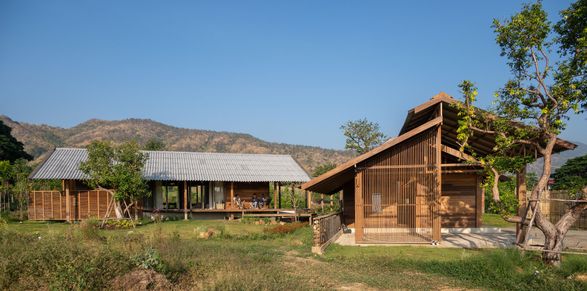
Baan Sao Yong Hin House
ARCHITECTS
Housescape Design Lab
CLIENTS
Khun Muenprae, Khun Tritep
LEAD ARCHITECTS
Peerapong Promchart
HOUSESCAPE RESEARCH TEAM
Timpika Wetpanya, Nattikarn Krooba
DESIGN TEAM
Panuwat Donthong, Pimprutti Pruttichote, Puttipong Penthong, Jil Gielen, Thiprada Jindatum
STRUCTURAL ENGINEER
Rachaen Jannakham
LANDSCAPE
Housescape Design Lab
SPECIAL THANKS FOR ACADEMIC PAPER
Kanitta Pansri; Prof. Dr.vira Inpuntung
WOOD FINDER
Bua Baan Mai Kao
CONTRACTOR
Mongkol Boonrueng
PHOTOGRAPHS
Rungkit Charoenwat
AREA
300 M²
YEAR
2025
LOCATION
Thailand
CATEGORY
Houses
Text description provided by architect.
Over the past year, our studio has been deeply engaged in working with domestic materials, conducting experiments with these processes in two to three projects.
One of these projects is a residential house located in Lom Sak District, Phetchabun Province, situated in the "Phetchabun Basin", which lies in the central-northern region of Thailand.
The genesis of this residence was rooted in a careful analysis of the power of its location. The most striking geographical feature is Khao Nam Ko Yai, a prominent mountain that forms a powerful backdrop to the site.
The proximity of the mountain also contributes to a recurring downslope wind that passes through the house. Furthermore, a critical aspect derived from the site is the subsurface composition of large gravel deposits within the sedimentary layer.
This geological characteristic aligns with prior research on vernacular house construction in this region, where stone is traditionally used as a foundation for supporting house posts. This aspect will be further elaborated in the following discussion.
Before conceptualizing the spatial arrangement of the house, we conducted an extensive research process.
We owe a great deal to the research paper "Hean Sao Yong Hin" by Kanittha Pansri and Professor Dr. Veera Inpantang, which provided a framework for understanding vernacular architecture in the Phetchabun Basin.
We were particularly fortunate to find that the research findings were highly consistent with the site's geological characteristics, offering a historical foundation that significantly informed the continuity of this project.
One major limitation we faced was sourcing reclaimed timber from old houses in this region, which proved to be a challenging task. Consequently, we adjusted our approach by procuring timber from Chiang Mai instead.
We dismantled three old houses in the suburban districts of Chiang Mai, meticulously documenting their proportions and surface characteristics.
A small research team was tasked with developing models to explore the potential of repurposing these materials for new spatial functions.
The outcome was a discovery of new architectural possibilities beyond the conventional vernacular design framework, challenging traditional floor plan arrangements and introducing new patterns of connectivity between doors and windows while preserving traces of previous usage.
A defining characteristic of this residence is its use of stone as a foundational base for the wooden columns.
These stones, naturally embedded beneath the site, were carefully excavated only to the extent necessary for construction, ensuring that the geological balance remained intact.
This approach resonates with local architectural wisdom, yet it also raised concerns regarding structural integrity in response to increasingly unpredictable climatic conditions.
To address this, we integrated reinforced concrete (RC) elements into the structural system.
Steel L-Bolts (20 mm in diameter) were embedded into the RC foundation before being anchored into the stone bases beneath each wooden column, thereby ensuring structural stability while maintaining the historical continuity of vernacular construction techniques.
This method provided both aesthetic continuity and enhanced safety for the inhabitants.
Given Thailand's tropical climate, roofing, and eaves play a crucial role in passive cooling strategies. While modern technology offers various thermal insulation solutions, we selectively applied them only beneath the roof, as it is the most heat-exposed surface.
For lateral heat mitigation, we adhered to the principle that air circulation itself serves as a powerful thermal buffer, facilitated by the downslope wind and the extensive eaves that envelop the house. This passive strategy significantly contributes to thermal comfort within the residence.
The traces of human craftsmanship have always been a central focus of our studio's work. We deeply appreciate the homeowners for their openness and willingness to embrace the inherent imperfections of the materials.
The walls resist the industrial pursuit of smooth perfection, the reclaimed wood retains the marks of its previous use, and the organic unpredictability of natural stone shapes each foundation uniquely.
Nearly all the furniture and lighting fixtures were designed, prototyped, and refined in our studio before being installed in this house. It is a home imbued with craftsmanship that values practicality and human touch.
A simple "Sai Kai" (serpentine) canal system was excavated to facilitate water flow and promote natural bioremediation.
Instead of pursuing a manicured lawn aesthetic, we allowed for a heterogeneous mix of plant species to coexist, fostering an ecological dialogue among various plant forms.
This approach moves beyond the conventional notion that only uniform green grass enhances a residence's visual appeal; rather, the presence of diverse vegetation contributes to the natural equilibrium of the ecosystem.



























